|

- Painted limestone Bust of Prince Ankh-Haf (h.50.5 cm) dating to the reign of Khafre, 2558-2532 BC
4th Dynasty. Giza, tomb G 7510 (27.442), excavated by the Harvard University-Boston Museum of Fine Arts
Expedition; 1927: assigned to the MFA in the division of finds by the government of Egypt.
In ancient Egypt, artists rarely created true portraits following a perceptual rather than
conceptual style. This bust of Ankh-Haf breaks this 'rule'. It is
made of limestone covered with a thin layer of plaster, into which details have been modelled by the hand of a master.
Rather than a stylized representation, the face is of an individual. From inscriptions in his tomb, we know that Ankh-Haf
was the son of King Sneferu, half-brother of King Khufu, and that he served Khafre as Vizier and Overseer of
Works. In this last capacity, he may have overseen the building of the second pyramid at the Giza complex and the carving of the sphinx.
Ankh-Haf's features are those of a mature man and his head has a receding hairline. His eyelids droop slightly over eyes
originally painted white with brown pupils. Puffy pouches are rendered underneath. Diagonal furrows set off a stern
mouth. Apparently, he once had a short beard made from a separate piece of plaster. It was lost in antiquity, as were
his ears. His gaze is that of a commanding and determined man, someone who was accustomed to having his orders obeyed. It
was the way he wanted to be remembered for eternity.
Ankh-Haf's mastaba was the largest in the great Eastern Cemetery at Giza. His bust was installed in a mud-brick chapel
attached to the east side of the tomb and oriented so that it faced the chapel's entryway.
The chapel walls were covered in exquisitely modelled low relief. It has been suggested that Ankh-Haf's arms were
sculpted on the low pedestal on which he sat, thereby making him appear even more lifelike. It is possible that the arms
held an offering table. More than
ninety models of food and drink for Ankh-Haf to enjoy in the afterlife.
The precise function of the bust is not clear and it was discovered lying on the floor of the mud-brick chapel just
outside of the tomb. This unusual arrangement is paralleled in the tomb of Vizier Idu (6th Dynasty) located close to G
7510. It is possible that Idu's sculptors used Ankh-Haf's bust as an example or prototype.
Ankh-Haf's unique, and by the terms of the Museum's contract with the Egyptian government, he should have gone to the
Cairo Museum. However, he was awarded to Boston by the Antiquities Service in gratitude for the Harvard-Boston
Expedition's work to excavate and restore objects from the tomb of Queen Hetepheres.
However, Dr Zahi Hawass said during a speech at a meeting of the Intergovernmental Committee for Promoting the
Return of Cultural Property to its Countries of Origin held at UNESCO in Paris there are five key artefacts [that should
be returned to Egypt] the Dendara Zodiac in the Louvre, the Rosetta Stone in the British Museum, the bust of Nefertiti
in Berlin, the bust of Hemiunu in Hildesheim and the bust of Ankh-Haf in Boston, that I would like to come back to be
shown in a temporary exhibition here, so that the Egyptian people can see these important treasures.
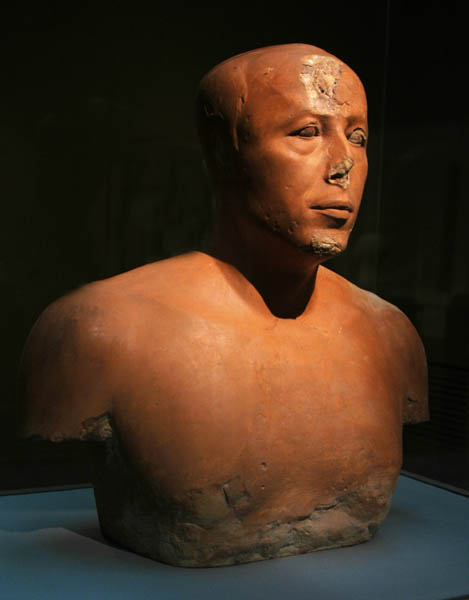

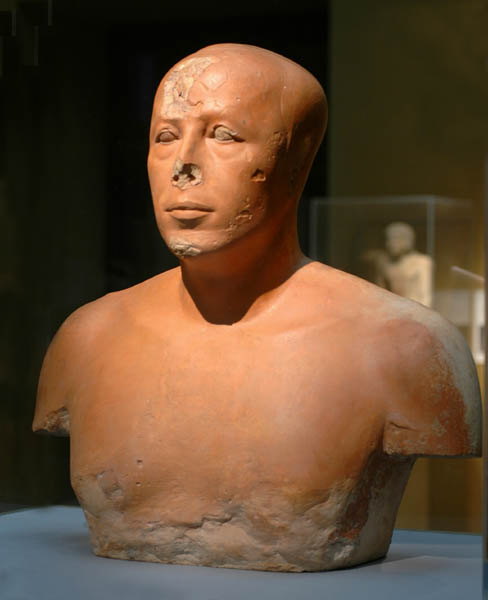
The structure of Egyptian society has often been compared to a pyramid, with the king at the
apex, the bureaucratic class made up of the king's trusted officials in the middle, and farmers and other labourers
making up the broad base. Estimates place the population of Egypt in the Old Kingdom at about two million, although only
the smallest fraction of those numbered among the official class and left records.'9 Most information about these people
and how they lived comes from their funerary remains, particularly from the relief and paintings that decorated tomb
walls. Substantial towns of the Old Kingdom have been excavated at Elephantine and Ayn-Asil in the Dakhleh Oasis, both
remote from the Memphite area. These towns were protected by substantial mud-brick walls and included densely packed
houses, administrative buildings, industrial areas, crafts workshops, and temples to local deities."
Just as pyramids and their associated structures provide most of our information about kings and kingship in the Old
Kingdom, burial places that surrounded each pyramid for the king's elite supply a wealth of information about daily
life, including family structure, clothing, food and drink, occupations, and leisure activities. At times mimicking the
layout of royal funerary establishments, they could reach an enormous size." Substantial numbers of private tombs were
also located in provincial centres, particularly during the later Old Kingdom.
Statuary and relief indicate that Egyptian men married one wife at a time and were proudly represented for eternity with
their spouses and children. Depictions rarely provide reliable indicators of age, for just as kings were depicted in the
prime of youth with perfect bodies, so too were most officials and their wives. The occasional corpulence in a man
signified maturity and prosperity. Generally faces as well were idealized, although a few exceptions demonstrate that
artists were capable of superb portraiture when called upon to produce it.
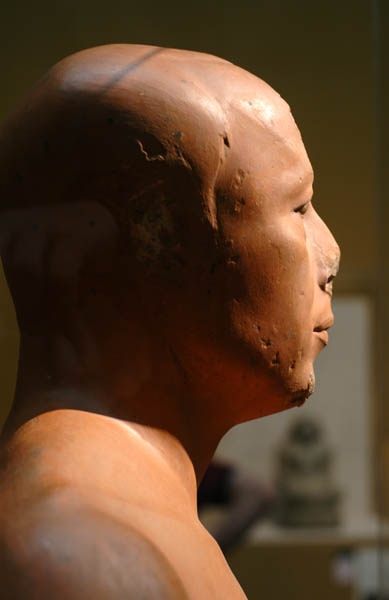  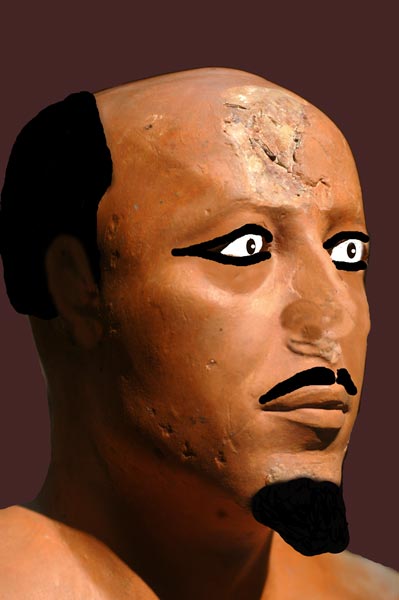 Ankh-Haf's
bust would have had a slightly different look when it was originally completed. This image (left) with the receding
hair-line re-painted, the missing beard and ears
added and also the eyes re-painted painted white with brown pupils help to demonstrate this. The bust's face was painted
red to indicate 'life' and in life he would have spent considerable time having white face-paint applied. Ankh-Haf's
bust would have had a slightly different look when it was originally completed. This image (left) with the receding
hair-line re-painted, the missing beard and ears
added and also the eyes re-painted painted white with brown pupils help to demonstrate this. The bust's face was painted
red to indicate 'life' and in life he would have spent considerable time having white face-paint applied. |
|

 |
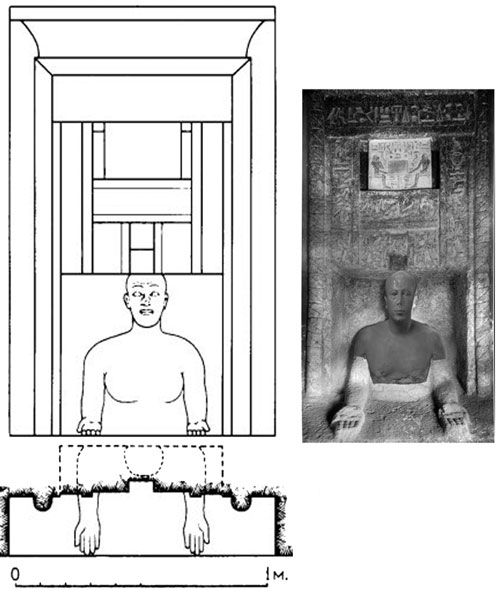 What might Ankh-Haf's bust
originally have look like..? What might Ankh-Haf's bust
originally have look like..?
This question is addressed in the
Journal of the Museum of Fine Art,
Boston Volume 3 1991 (which is available form the Giza
Archive Project web site) in a article written by Dr Andrey Bolshakov (Keeper of Egyptian Antiquities at the Hermitage
Museum, Leningrad). It proposes that the bust was from a false-door and offering table and used Idu's tomb (G 7102) at
Giza to demonstrate this. The bust would have been set into the false door which had the arms and remainder of a torso.
This image is a combination of the a 1927 photo of Idu's tomb with the Ankh-Haf overlaid onto it. In it original
brightly painted form it would have made an impressive offering place for the Prince's funerary cult.
|
|
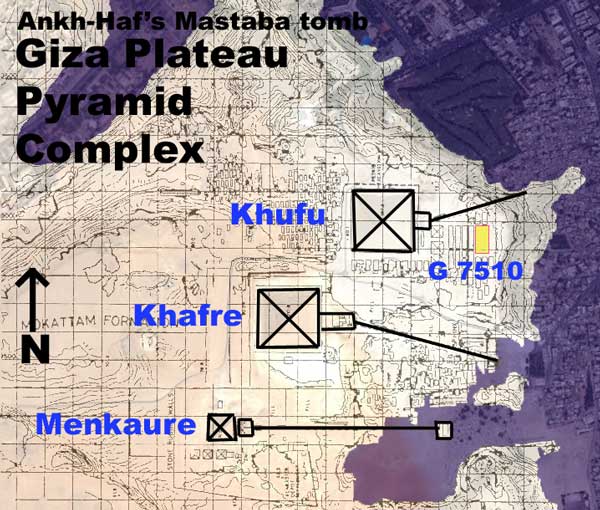
The Giza Plateau
The plateau is formed from horizontal strata of
sedimentary limestone; it was an ideal site, with no overburden to be removed and the natural bedding planes made
quarrying easy. The complex represents a colossal human achievement and is the pinnacle of pyramid construction. The
pyramids were built using precise measurements and accurate construction giving a north alignment. Non-royal burials are
clustered and laid-out like an organized town. G 7510, which would have been given by the King to Ankh-Haf was
significantly larger than those surrounding it. From his position as Vizier we can surmise that he was a powerful and
influential person.
The internal structure has many new features with
three burial chambers; the King’s chamber has five stress-relieving chambers demonstrating an advanced understanding of
engineering. The Grand gallery, built with an extravagant corbelled structure, is over 46m long and is an engineering
master-piece. Efforts were made to prevent tomb robbery but it was plundered during the Old Kingdom. There are four
mysterious “airshafts” and their purpose is still uncertain. Within the enclosure where three pyramids for queens, they
were built to a scale of approximately one-fifth size. A number of rock-cut boat pits have been found and one sacred
bark has been reassembled.
|
| 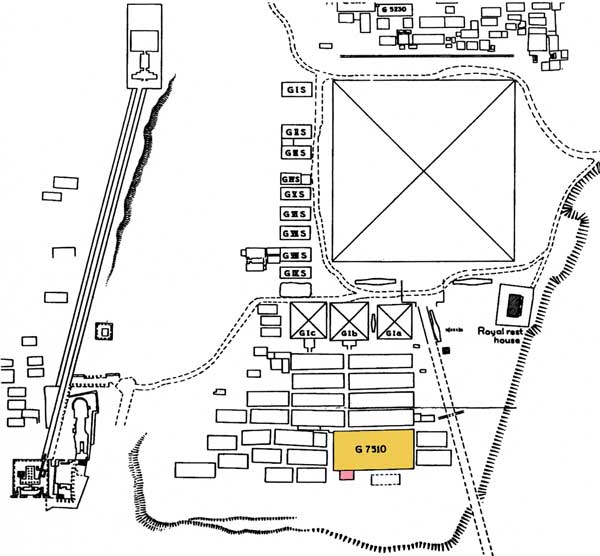
|
| 
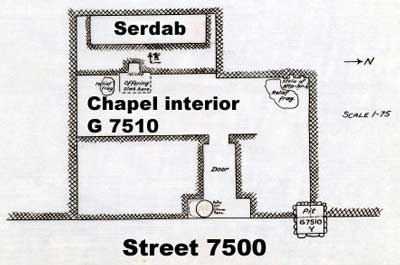
|
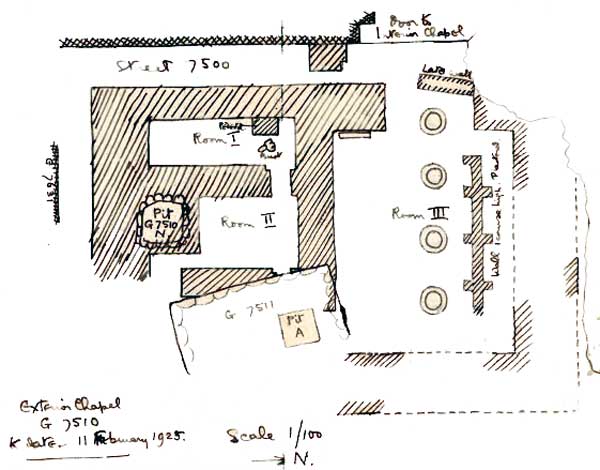 - The above pictures show the structure of the Mastaba and it's pit, which contained Ankh-Haf's
burial.
-
- The Old Kingdom Mastaba burials evolved from a simple super-structure, which helped to protect the burial from looting and
erosion, into a more complex structure with statues within a serdab, false doors and rock-cut chamber replacing pits. False-doors for offerings to the deceased evolved into offering rooms
- which
also evolved into a chamber or chapel with decorated panels and also stelae.
-
- From the sketch (left) of the original excavation on 11-Feb-1925 the location of Ankh-Haf's
bust in Room I can be determined. At the top right is the door-way into the Chapel.
-
- Pit A, Pit N and Mastaba 7511 demonstrate the re-used and over-use that Mastaba G 7510 underwent over a
period of time.
|
Sources
Arts of Ancient Egypt;2003; MFA Publication>
Egypt in the Age of the Pyramids; Markowitz, Haynes and Freed; 2002; MFA Publication>
Internet, Boston Museum of Fine Art>
Giza Archives Project>
| |






 Ankh-Haf's
bust would have had a slightly different look when it was originally completed. This image (left) with the receding
hair-line re-painted, the missing beard and ears
added and also the eyes re-painted painted white with brown pupils help to demonstrate this. The bust's face was painted
red to indicate 'life' and in life he would have spent considerable time having white face-paint applied.
Ankh-Haf's
bust would have had a slightly different look when it was originally completed. This image (left) with the receding
hair-line re-painted, the missing beard and ears
added and also the eyes re-painted painted white with brown pupils help to demonstrate this. The bust's face was painted
red to indicate 'life' and in life he would have spent considerable time having white face-paint applied. What might Ankh-Haf's bust
originally have look like..?
What might Ankh-Haf's bust
originally have look like..?






